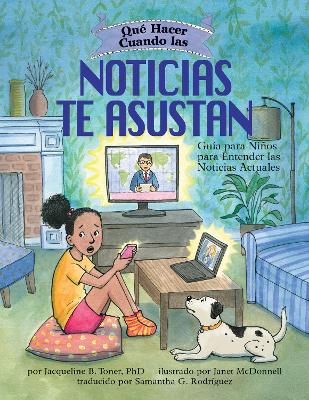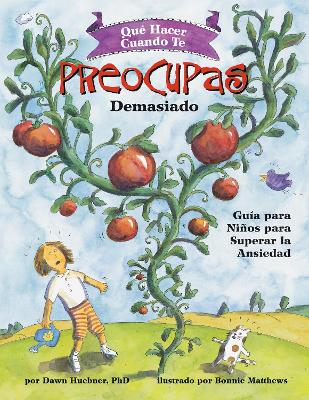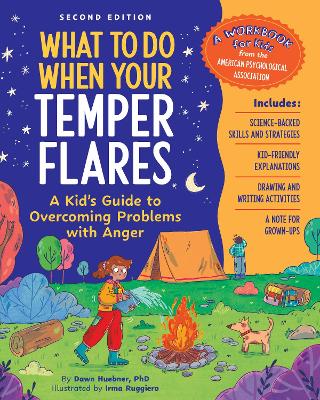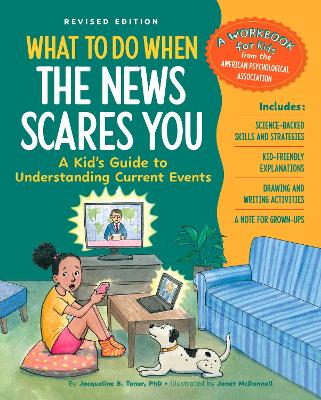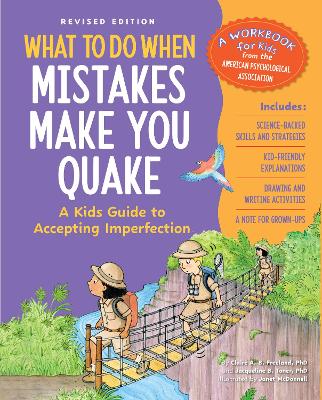What-to-Do Guides for Kids
7 total works
What to Do When the News Scares You
by Jacqueline B. Toner and Janet McDonnell
Published 5 October 2021
This latest installment in the bestselling What To Do series tackles children’s feelings of anxiety around current events and what is portrayed in the news. Scary news is an inevitable part of life. This book can support and guide efforts to help scary news seem a bit more manageable for young people.
Whether from television news reports, the car radio, digital media, or adult discussions, children are often bombarded with information about the world around them. When the events being described include violence, extreme weather events, a disease outbreak, or discussions of more dispersed threats such as climate change, children may become frightened and overwhelmed. Parents and caregivers can be prepared to help them understand and process the messages around them by using this book.
What to Do When the News Scares You provides a way to help children put scary events into perspective. And, if children start to worry or become anxious about things they’ve heard, there are ideas to help them calm down and cope. This book also helps children identify reporters’ efforts to add excitement to the story which may also make threats seem more imminent, universal, and extreme.
Read and complete the activities in What to Do When the News Scares You with your child to help them to understand the news in context—who, what, where, when, how—as a means of introducing a sense of perspective.
Also available in Spanish Qué Hacer Cuando las Noticias te Asustan: Guía para Niños para Entender las Noticias Actuales
Whether from television news reports, the car radio, digital media, or adult discussions, children are often bombarded with information about the world around them. When the events being described include violence, extreme weather events, a disease outbreak, or discussions of more dispersed threats such as climate change, children may become frightened and overwhelmed. Parents and caregivers can be prepared to help them understand and process the messages around them by using this book.
What to Do When the News Scares You provides a way to help children put scary events into perspective. And, if children start to worry or become anxious about things they’ve heard, there are ideas to help them calm down and cope. This book also helps children identify reporters’ efforts to add excitement to the story which may also make threats seem more imminent, universal, and extreme.
Read and complete the activities in What to Do When the News Scares You with your child to help them to understand the news in context—who, what, where, when, how—as a means of introducing a sense of perspective.
Also available in Spanish Qué Hacer Cuando las Noticias te Asustan: Guía para Niños para Entender las Noticias Actuales
Qué Hacer Cuando las Noticias te Asustan
by Jacqueline B. Toner, Samantha G Rodriguez, and Janet McDonnell
Published 5 October 2021
Esta última entrega de la serie “Qué Hacer” más vendida abarca los sentimientos de ansiedad de los niños en torno a los acontecimientos actuales y a lo que aparece en las noticias. Las noticias aterradoras son una parte inevitable de la vida. Este libro puede apoyar y guiar los esfuerzos para que las noticias aterradoras parezcan un poco más manejables para los jóvenes.
Ya sea a través de la televisión, de la radio de tu carro o las conversaciones de los adultos, los niños suelen ser bombardeados con noticias. Cuando los acontecimientos que se describen incluyen violencia, fenómenos meteorológicos extremos, un brote de una enfermedad o discusiones sobre amenazas más dispersas, como el cambio climático, los niños pueden asustarse y sentirse abrumados. Los padres y cuidadores pueden estar preparados para ayudarles a entender y procesar los mensajes que les rodean utilizando este libro.
Qué Hacer Cuando las Noticias te Asustan ofrece ayudar a los niños a poner en perspectiva los sucesos que les asustan. Si los niños empiezan a preocuparse o a ponerse ansiosos por las cosas que han oído, hay formas para ayudarles a calmarse y sobrellevar la situación. Este libro también ayuda a los niños a identificar los esfuerzos de los reporteros por añadir emoción a la historia, lo que también puede hacer que las amenazas parezcan más inminentes, universales y extremas.
Lea y complete las actividades que están en Qué hacer cuando las noticias te asustan con su hijo para ayudarle a entender las noticias en su contexto -quién, qué, dónde, cuándo, cómo- como medio de introducir un sentido de la perspectiva.
Ya sea a través de la televisión, de la radio de tu carro o las conversaciones de los adultos, los niños suelen ser bombardeados con noticias. Cuando los acontecimientos que se describen incluyen violencia, fenómenos meteorológicos extremos, un brote de una enfermedad o discusiones sobre amenazas más dispersas, como el cambio climático, los niños pueden asustarse y sentirse abrumados. Los padres y cuidadores pueden estar preparados para ayudarles a entender y procesar los mensajes que les rodean utilizando este libro.
Qué Hacer Cuando las Noticias te Asustan ofrece ayudar a los niños a poner en perspectiva los sucesos que les asustan. Si los niños empiezan a preocuparse o a ponerse ansiosos por las cosas que han oído, hay formas para ayudarles a calmarse y sobrellevar la situación. Este libro también ayuda a los niños a identificar los esfuerzos de los reporteros por añadir emoción a la historia, lo que también puede hacer que las amenazas parezcan más inminentes, universales y extremas.
Lea y complete las actividades que están en Qué hacer cuando las noticias te asustan con su hijo para ayudarle a entender las noticias en su contexto -quién, qué, dónde, cuándo, cómo- como medio de introducir un sentido de la perspectiva.
Qué Hacer Cuando te Preocupas Demasiado
by Dawn Huebner, Bonnie Matthews, and Samantha G Rodriguez
Published 5 October 2021
Ganador del premio Gold NAPPA (Premios nacionales de publicaciones para padres)
¿Sabías que las preocupaciones son como los tomates? No, no puedes comerlas, pero puedes hacerlas crecer, simplemente hay que prestarle atención. Si tus preocupaciones han crecido de tal manera que te molestan casi todos los días, entonces este libro es para ti.
Qué hacer cuando te preocupas demasiado sirve para guiar a padres y a niños a través de las técnicas cognitivo-conductuales más usadas en el tratamiento para la ansiedad. Las metáforas e ilustraciones en este libro hacen que los conceptos y estrategias sean más fáciles de entender, mientras que los pasos que muestran cómo hacerlo y las indicaciones para dibujar y escribir ayudan a los niños a dominar las nuevas habilidades relacionadas con la reducción de la ansiedad. Este interactivo libro para la autoayuda es el mejor recurso para educar, motivar y capacitar a los niños para que superen sus preocupaciones excesivas.
Atractivo, alentador y fácil de seguir, este libro educa, motiva y capacita a los niños para trabajar hacia el cambio. Incluye una nota para los padres por la psicóloga y autora Dawn Huebner, PhD.
Sacado de la Nota para los padres:
Si es padre o cuidador de un niño con ansiedad, sabe lo que se siente ser un rehén. Su hijo también lo sabe. Los niños que se preocupan demasiado son prisioneros de sus miedos. Hacen todo lo posible por evitar situaciones que les causan miedo y hacen las mismas preguntas de ansiedad una y otra vez. Sin embargo, las respuestas no les dan prácticamente ningún alivio. Los padres y cuidadores pasan mucho tiempo tranquilizando, persuadiendo, acomodando y haciendo cualquier otra cosa que se les ocurra para minimizar la angustia de su hijo.
Pero no funciona. La ansiedad sigue teniendo el control. Como indudablemente ha descubierto, decir simplemente a un niño ansioso que deje de preocuparse no ayuda en absoluto. Tampoco ayuda aplicar lógica de adultos, ni permitir que su hijo evite las situaciones temidas, ni consolándolo cada vez que exprese sus temores.
Este libro forma parte de la serie de guías “QUÉ HACER” para niños (What-to-Do Guides for Kids®) de Magination Press e incluye una "Introducción para padres y cuidadores". What-to-Guides for Kids® son libros interactivos de autoayuda diseñados para guiar a niños de 6 a 12 años y a sus padres a través de las técnicas cognitivo-conductuales más utilizadas en el tratamiento de diversas preocupaciones psicológicas. Atractivos, alentadores y fáciles de seguir, estos libros educan, motivan y capacitan a los niños para trabajar hacia el cambio.
¿Sabías que las preocupaciones son como los tomates? No, no puedes comerlas, pero puedes hacerlas crecer, simplemente hay que prestarle atención. Si tus preocupaciones han crecido de tal manera que te molestan casi todos los días, entonces este libro es para ti.
Qué hacer cuando te preocupas demasiado sirve para guiar a padres y a niños a través de las técnicas cognitivo-conductuales más usadas en el tratamiento para la ansiedad. Las metáforas e ilustraciones en este libro hacen que los conceptos y estrategias sean más fáciles de entender, mientras que los pasos que muestran cómo hacerlo y las indicaciones para dibujar y escribir ayudan a los niños a dominar las nuevas habilidades relacionadas con la reducción de la ansiedad. Este interactivo libro para la autoayuda es el mejor recurso para educar, motivar y capacitar a los niños para que superen sus preocupaciones excesivas.
Atractivo, alentador y fácil de seguir, este libro educa, motiva y capacita a los niños para trabajar hacia el cambio. Incluye una nota para los padres por la psicóloga y autora Dawn Huebner, PhD.
Sacado de la Nota para los padres:
Si es padre o cuidador de un niño con ansiedad, sabe lo que se siente ser un rehén. Su hijo también lo sabe. Los niños que se preocupan demasiado son prisioneros de sus miedos. Hacen todo lo posible por evitar situaciones que les causan miedo y hacen las mismas preguntas de ansiedad una y otra vez. Sin embargo, las respuestas no les dan prácticamente ningún alivio. Los padres y cuidadores pasan mucho tiempo tranquilizando, persuadiendo, acomodando y haciendo cualquier otra cosa que se les ocurra para minimizar la angustia de su hijo.
Pero no funciona. La ansiedad sigue teniendo el control. Como indudablemente ha descubierto, decir simplemente a un niño ansioso que deje de preocuparse no ayuda en absoluto. Tampoco ayuda aplicar lógica de adultos, ni permitir que su hijo evite las situaciones temidas, ni consolándolo cada vez que exprese sus temores.
Este libro forma parte de la serie de guías “QUÉ HACER” para niños (What-to-Do Guides for Kids®) de Magination Press e incluye una "Introducción para padres y cuidadores". What-to-Guides for Kids® son libros interactivos de autoayuda diseñados para guiar a niños de 6 a 12 años y a sus padres a través de las técnicas cognitivo-conductuales más utilizadas en el tratamiento de diversas preocupaciones psicológicas. Atractivos, alentadores y fáciles de seguir, estos libros educan, motivan y capacitan a los niños para trabajar hacia el cambio.
What to Do When You Worry Too Much, Second Edition, guides children and parents through the cognitive-behavioral techniques most often used in the treatment of anxiety. Now revised and expanded, this groundbreaking bestseller has helped millions of children around the world.
An updated edition of the world-wide bestseller What to Do When You Worry Too Much, the second edition combines everything that worked so well in the original—the conversational tone, interactive elements, clear and actionable strategies—with
new tools, new illustrations, and expert advice based on current understandings of anxiety. Lively metaphors and humorous illustrations make the concepts and strategies easy to understand, while clear how-to steps and prompts to draw and write help children learn new skills. This interactive self-help book remains the complete resource for educating, motivating, and empowering kids to overcome their overgrown worries. Includes a note to parents and caregivers by psychologist author Dawn Huebner, PhD.
This book is part of the Magination Press What-to-Do Guides for Kids® series and includes a “Note to Parents and Caregivers.” What-to-Guides for Kids® are interactive self-help books designed to guide 6–12 year olds and their parents through the cognitive-behavioral techniques most often used in the treatment of various psychological concerns. Engaging, encouraging, and easy to follow, these books educate, motivate, and empower children to work towards change.
An updated edition of the world-wide bestseller What to Do When You Worry Too Much, the second edition combines everything that worked so well in the original—the conversational tone, interactive elements, clear and actionable strategies—with
new tools, new illustrations, and expert advice based on current understandings of anxiety. Lively metaphors and humorous illustrations make the concepts and strategies easy to understand, while clear how-to steps and prompts to draw and write help children learn new skills. This interactive self-help book remains the complete resource for educating, motivating, and empowering kids to overcome their overgrown worries. Includes a note to parents and caregivers by psychologist author Dawn Huebner, PhD.
This book is part of the Magination Press What-to-Do Guides for Kids® series and includes a “Note to Parents and Caregivers.” What-to-Guides for Kids® are interactive self-help books designed to guide 6–12 year olds and their parents through the cognitive-behavioral techniques most often used in the treatment of various psychological concerns. Engaging, encouraging, and easy to follow, these books educate, motivate, and empower children to work towards change.
If you're a kid whose anger gets too big, too hot, too fast, this book is for you.
An updated edition of the interactive self-help book, What to Do When Your Temper Flares, Second Edition, pairs everything that worked so well in the original—the conversational tone, interactive elements, clear and actionable strategies—with new tools, new illustrations, and up-to-date expert advise. Lively metaphors make concepts easy to understand while clear, how-to steps and prompts to draw and write arm children with a set of anger dousing methods aimed at cooling angry thoughts and controlling angry actions, resulting in calmer, more effective kids. This interactive self-help book is the complete resource for educating, motivating, and empowering children to work toward change.
Includes a note to parents and caregivers by Dawn Huebner, PhD.
An updated edition of the interactive self-help book, What to Do When Your Temper Flares, Second Edition, pairs everything that worked so well in the original—the conversational tone, interactive elements, clear and actionable strategies—with new tools, new illustrations, and up-to-date expert advise. Lively metaphors make concepts easy to understand while clear, how-to steps and prompts to draw and write arm children with a set of anger dousing methods aimed at cooling angry thoughts and controlling angry actions, resulting in calmer, more effective kids. This interactive self-help book is the complete resource for educating, motivating, and empowering children to work toward change.
Includes a note to parents and caregivers by Dawn Huebner, PhD.
This updated edition in the bestselling What To Do series cansupport and guide efforts to help scary news seem a bit more manageable for young people.
Scary news is an inevitable part of life. Whether from television news reports, the car radio, digital media, or adult discussions, children are often bombarded with unsettling information about the world around them. When the events being described include violence, extreme weather events, a disease outbreak, or discussions of more dispersed threats such as climate change or terrorism, children can get frightened and overwhelmed just like adults. This book tackles children’s anxiety and stress around how events are portrayed in the news and how kids might process news to become an informed media consumer. Parents and caregivers can be prepared to help them understand and process the messages around them by using this book.
What to Do When the News Scares You provides a way to help children put scary events into perspective. And, if children start to worry or become anxious about things they’ve heard, there are ideas to help them calm down and cope.
Scary news is an inevitable part of life. Whether from television news reports, the car radio, digital media, or adult discussions, children are often bombarded with unsettling information about the world around them. When the events being described include violence, extreme weather events, a disease outbreak, or discussions of more dispersed threats such as climate change or terrorism, children can get frightened and overwhelmed just like adults. This book tackles children’s anxiety and stress around how events are portrayed in the news and how kids might process news to become an informed media consumer. Parents and caregivers can be prepared to help them understand and process the messages around them by using this book.
What to Do When the News Scares You provides a way to help children put scary events into perspective. And, if children start to worry or become anxious about things they’ve heard, there are ideas to help them calm down and cope.
What to Do When Mistakes Make You Quake
by Jacqueline B. Toner and Claire A. B. Freeland
Published 7 January 2025
This interactive self-help book guides children and their parents through the emotions underlying a fear of making mistakes using strategies and techniques based on cognitive-behavioral principles.
What to Do When Mistakes Make You Quake helps kids takes the fear out of failing and making mistakes to just keep on going! Kids who worry about being wrong try to control situations to ensure their success, blame others for their failings, or be critical in general. They may have trouble making decisions for fear of making the wrong one. It’s exhausting trying to avoid mistakes. This interactive self-help book is the complete resource for educating, motivating, and empowering children to cope with mistakes — so they can explore new territory without fear!
What to Do When Mistakes Make You Quake helps kids takes the fear out of failing and making mistakes to just keep on going! Kids who worry about being wrong try to control situations to ensure their success, blame others for their failings, or be critical in general. They may have trouble making decisions for fear of making the wrong one. It’s exhausting trying to avoid mistakes. This interactive self-help book is the complete resource for educating, motivating, and empowering children to cope with mistakes — so they can explore new territory without fear!

